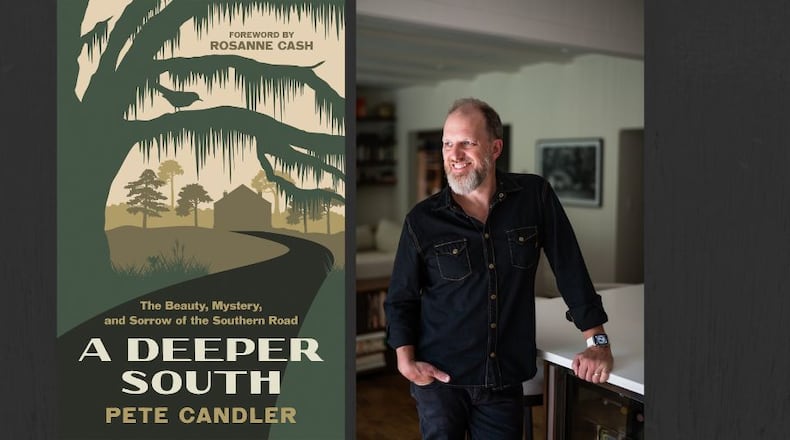The South has 400 years or so of history to contend with, but only about four years that seem to really matter.
“This short half-decade disproportionately dominates the collective conscience in the South, as if there were no South before, and not much of one after,” writes Pete Candler in “A Deeper South,” his new book of travels in and musings on the South, present and past.
Look no further than the recent proposal to place a statue of Hank Aaron in the U.S. Capitol’s National Statuary Hall (each state is allowed two). And who would Aaron replace? None other than Georgia’s Alexander Stephens, vice president of the Confederate States of America, who was given that honor by the Georgia legislature in 1927 after stating that slavery was the “natural and normal condition” of Black people. He stands there to this day, representing all the people of Georgia.
“A Deeper South” is a combination of history, travelogue, memoir and social commentary, which, while veering off on many, many discursions, keeps coming back to Candler’s main theme of how the insidious “Lost Cause” myth speckled our landscape with so many Confederate monuments.
The author is a Candler of the Candlers; his family tree includes the men who founded the Coca-Cola Company and Emory University, as well as assorted Georgia senators, governors, judges and militia leaders — many of whom did not live their lives on what he considers the right side of history.
After growing up a self-described “white male of privilege” in Atlanta, Candler awakened in college to the complicated history of both his ancestors and his home. He became a professor of theology at Baylor University but felt that as an academic he had become “a truncated version of myself” and resigned his tenured position, the better to create works like “A Deeper South.”
Back in college in the late ‘90s, Candler and a friend drove the back roads of the South, soaking in the quirks and vagaries of the most remote locations. A few years ago, he retraced many of those earlier journeys, hitting Georgia, Tennessee, South Carolina, Florida, Alabama and Mississippi, taking photographs and notes as he went.
During his travels, Candler was struck by the gap between the South’s 2,000 or so Confederate memorials and the absence of commemoration for the thousands of Black people who were lynched from the late 1800s to the late 1960s.
Confederate monuments were few after the war ended, Candler explains. Then from 1900-1920, as white supremacy locked down the region again, they sprang up everywhere, frequently near courthouses. Their true purpose was not honoring the dead, he writes, but staking a claim to that territory as “white space.”
There was no bar too low for the United Daughters of the Confederacy’s zeal in rewriting history. Henry Wirz, the commandant of the Andersonville prison camp in South Georgia, was one of only a handful of men to be tried and executed for war crimes. But the organization erected a large obelisk in his honor in the center of Andersonville “to rescue his name from the stigma attached to it by embittered prejudice,” according to the plaque.
It’s not just Confederate statuary that riles Candler. The life-size statue honoring James Brown in his adopted hometown of Augusta shows “no trace of James’s ferocious virility, no sign of the agony – sexual, racial, political – that Brown projected…” The statue “seems an attempt to cut him down to” size, erected reluctantly by “a city that has long been uneasy about him.”
In a terse and brutal stab of art criticism, he describes Brown’s statue as “a Black version of Josh Groban. With a cape.”
Candler ventures far and wide through the six states, hitting the usual suspects — Tuskegee, Alabama, home of the HBCU founded by Booker T. Washington; the crossroads in Mississippi where blue legend Robert Johnson claimed to have sold his soul to the devil; Charleston, South Carolina; and Memphis -- and the unusual like Marietta’s Big Chicken, built in 1963 not to advertise a KFC but for a fast-food restaurant called Johnny Reb’s Chick-Chuck-’N’-Shake. Everything is rooted in those four years.
He lingers in the impenetrable mysteries of the Okefenokee Swamp, where, always the academic, he name-checks Homer, Virgil, Dante and cartoonist Walt (“Pogo”) Kelly, and writes about a misbegotten 19th century plan to clear and drain the swamp to provide valuable land. The reclamation project depended heavily on convict labor (aka slavery by another name). Fortunately, the swamp won and is now a U.S. National Wildlife Refuge, although a titanium mining company is trying once again to monetize this unique natural phenomenon.
Candler’s observational powers are astute. At Montgomery’s National Memorial for Peace and Justice, the names of 4,000 lynching victims are inscribed on hanging steel boxes that resemble caskets. “As the steel weathers, it oxidizes and becomes discolored like rust. … On many of them, the discoloration runs down the steel surface like a trail of blood.”
Candler can get a little wound up in his own family history, which is understandable, but it only makes the book longer rather than better.
The appeal of “A Deeper South” lies more in how much even a student of history can learn about tiny details of our regional past that matter. And as a student, perhaps not fall prey to one of his better aphorisms: “The one thing that is guaranteed never to go away no matter how much you ignore it is your own ignorance.”
About the book
“A Deeper South: The Beauty, Mystery, and Sorrow of the Southern Road”
By Pete Candler
University of South Carolina Press, 400 pages, $27.99
About the Author
Keep Reading
The Latest
Featured



